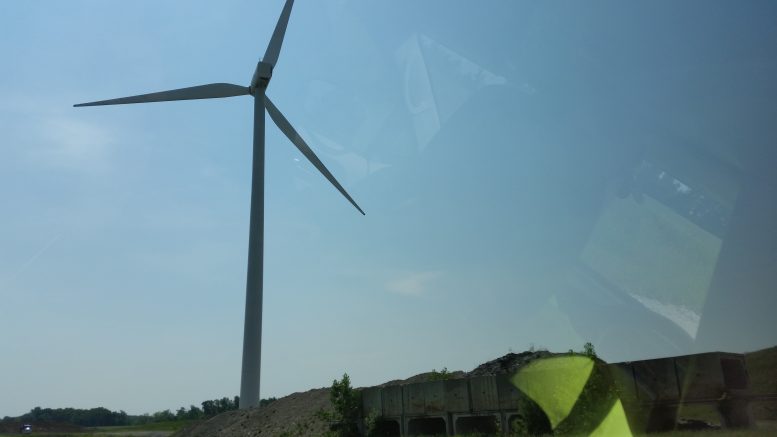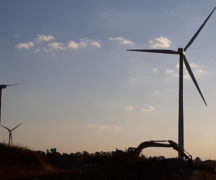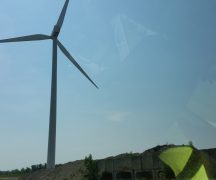By JAN LARSON McLAUGHLIN
BG Independent News
As Bowling Green’s aging wind turbines labor to produce power, city officials on Monday discussed buying some wind energy generated in Pennsylvania.
Twenty years ago, the city’s four giant wind turbines put Bowling Green on the green energy map. But those turbines are now industry dinosaurs.
“They don’t generate as much as they used to,” city Public Utilities Director Brian O’Connell said Monday evening. “But our goal is to keep them going as long as we can.”
One turbine has stopped working all together. The price tag to fix just the shorted out generator is close to $300,000, according to O’Connell.
Two others still turn wind into power, but they break down more often as they age. Only one turbine is running well.
“We’re trying to keep them going as long as they’re economically feasible,” O’Connell said.
“This technology is an older style,” with more mechanical pieces, he said. “Some of the parts are hard to acquire. They don’t make them anymore.”
The turbines were erected in 2002 and started cranking out power in 2003 – giving the city the distinction of being home to Ohio’s first utility-sized wind farm, located to the west of Bowling Green at the Wood County Landfill. The tall turbines stand out on the flat terrain, making them a local attraction.
“They are definitely a landmark in this area,” O’Connell said. “It’s not for a lack of trying to keep them going.”
At one time, the turbines generated up to 7.2 megawatts of power — enough to supply electricity for approximately 2,500 residential customers.
“They are still one of our lowest cost utility operations,” O’Connell said a couple years ago. “Whenever they spin, they make power. They are a cheap source of power for us.”
But the turbines have had more downtime for repairs. And the fixes aren’t cheap.
“We’ve had a couple of the gearboxes fail,” which can cost up to $500,000 to replace. Plus arranging for a crane tall enough to make the repairs can be time-consuming.
The four turbines are 257 feet tall – as tall as a 30-story building. With blades that extend 132 feet from the turbine casing, each unit measures nearly 400 feet tall when the blades rotate to their highest point.
The newer models are able to generate more power since they have longer blades. And some don’t have the gearbox at the top of the turbines, which make repairs easier.
But there are several downsides to replacing the aging turbines with new ones, he said.
First, the costs are steep.
When the wind turbines were erected in 2002, they cost about $2 million a piece. In 2020, the cost to replace them with newer models was estimated at $8.8 million a piece.
“The cost to put up a few units is pretty high,” O’Connell said.
Second, there’s the close proximity of a bald eagles’ nest to the wind turbines. Last year, a landfill employee heard a thud, and saw a bald eagle fall after being struck by a turbine blade, O’Connell said.
The remaining bald eagle found another mate, and had eaglets in the same nest to the east of the landfill this year. Since the birds have “protected” status, O’Connell said it would require special permits to erect new turbines near the nest.
And third, the state of Ohio has made it much more difficult for wind – and solar – farms to be built.
Debt on the existing wind turbine project was paid in full in 2015 – several years earlier than projected. And money has been set aside to remove the turbines when they are no longer operational.
“We’re going to run them till they’re not economically in our best interest,” O’Connell said.
At the same time that Bowling Green may be watching the end of its own turbines, the city is considering buying some wind energy generated in Pennsylvania.
The Board of Public Utilities voted Monday evening to enter an agreement to purchase wind power from the large Locust Ridge Wind Project in eastern Pennsylvania, to help power Bowling Green’s water and wastewater plants.
Jim Odneal, the city’s assistant utilities director, explained that short-term daily market purchases through the AMP Northern Power Pool will help the city weather expected power price hikes.
An ordinance is already in place allowing the utilities director to execute short term (less than one year) power purchases and sales with American Municipal Power in order to respond quickly to price fluctuations from the wholesale market.
From 2018 to early 2022, market energy prices were fairly low and stable. More recently, the short-term energy market prices have risen, and are expected to rise even higher in the coming months, Odneal said.
To soften the impact of the expected higher energy prices, AMP has negotiated a deal for wind power from the Locust Ridge Wind Project in eastern Pennsylvania.
Locust Ridge is a 100 MW wind project that has been in operation since 2009. The estimated savings would be $54,000 over three years for the Bowling Green water plant, and $82,000 over three years for the wastewater plant.



